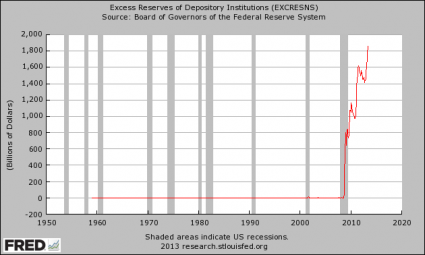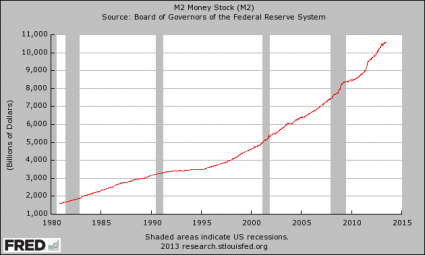By Michael Snyder, on July 1st, 2013
Did you know that U.S. banks have more than 1.8 trillion dollars parked at the Federal Reserve and that the Fed is actually paying them not to lend that money to us?
We were always told that the goal of quantitative easing was to "help the economy", but the truth is that the vast majority of the money that the Fed has created through quantitative easing has not even gotten into the system. Instead, most of it is sitting at the Fed slowly earning interest for the bankers.
Back in October 2008, just as the last financial crisis was starting, Federal Reserve Chairman Ben Bernanke announced that the Federal Reserve would start paying interest on the reserves that banks keep at the Fed. This caused an absolute explosion in the size of these reserves. Back in 2008, U.S. banks had less than 2 billion dollars of excess reserves parked at the Fed. Today, they have more than 1.8 trillion. In less than five years, the pile of excess reserves has gotten nearly 1,000 times larger. This is utter insanity, and it will have very serious consequences down the road.
Posted below is a chart that shows the explosive growth of these excess reserves in recent years...

This explains why all of the crazy money printing that the Fed has been doing has not caused tremendous inflation yet. Most of the money has not even gotten into the economy. The Fed has been paying banks not to lend it out.
But now that big pile of money is sitting out there, and at some point it is going to come pouring in to the U.S. economy. When that happens, we could very well see an absolutely massivetsunami of inflation.
Posted below is a chart that shows the growth of the M2 money supply over the past several decades. It has been fairly steady, but imagine what would happen if you took the hockey stick from the chart above and suddenly added it to the top of this one...

The longer that the Federal Reserve continues to engage in quantitative easing and continues to pay banks not to lend that money out to the rest of us, the larger that inflationary time bomb is going to become.
In a recent article for the Huffington Post, Professor Robert Auerbach of the University of Texas explained the nightmarish situation that we are facing...
More>
Did you know that U.S. banks have more than 1.8 trillion dollars parked at the Federal Reserve and that the Fed is actually paying them not to lend that money to us?
We were always told that the goal of quantitative easing was to "help the economy", but the truth is that the vast majority of the money that the Fed has created through quantitative easing has not even gotten into the system. Instead, most of it is sitting at the Fed slowly earning interest for the bankers.
Back in October 2008, just as the last financial crisis was starting, Federal Reserve Chairman Ben Bernanke announced that the Federal Reserve would start paying interest on the reserves that banks keep at the Fed. This caused an absolute explosion in the size of these reserves. Back in 2008, U.S. banks had less than 2 billion dollars of excess reserves parked at the Fed. Today, they have more than 1.8 trillion. In less than five years, the pile of excess reserves has gotten nearly 1,000 times larger. This is utter insanity, and it will have very serious consequences down the road.
Posted below is a chart that shows the explosive growth of these excess reserves in recent years...

This explains why all of the crazy money printing that the Fed has been doing has not caused tremendous inflation yet. Most of the money has not even gotten into the economy. The Fed has been paying banks not to lend it out.
But now that big pile of money is sitting out there, and at some point it is going to come pouring in to the U.S. economy. When that happens, we could very well see an absolutely massive
Posted below is a chart that shows the growth of the M2 money supply over the past several decades. It has been fairly steady, but imagine what would happen if you took the hockey stick from the chart above and suddenly added it to the top of this one...

The longer that the Federal Reserve continues to engage in quantitative easing and continues to pay banks not to lend that money out to the rest of us, the larger that inflationary time bomb is going to become.
In a recent article for the Huffington Post, Professor Robert Auerbach of the University of Texas explained the nightmarish situation that we are facing...
More>
